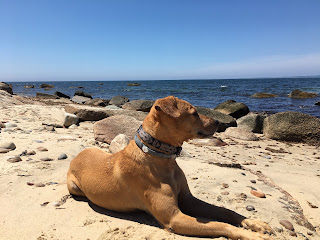Whit Sheppard is getting in his miles on the Vineyard this summer (near W. Tisbury) until mid-September and welcomes outreach from any classmates nearby. On island phone is 508-693-0579. There's scenery and a furry companion as well!
Thursday, July 25, 2019
Wednesday, July 24, 2019
Above Average!
From the Advancement Office:
"The results are in: We’re thrilled to report that thanks to the generosity of nearly 4,500 donors, Deerfield reached 45.1% alumni participation overall, the highest among our peer schools for the third time in the last four years!
Thank you for your part in this meaningful achievement. We’re fortunate to have so many dedicated alumni in our community, who truly “bleed green.” An alumnus suggested that it’s Deerfield’s continued commitment to sit-down meals that makes the difference in our participation—and that’s just one of the traditions that keep us strong.
Your class finished at 46% participation, a great result for a non-reunion year. Congrats!"
From Doug and JK:
Thanks so much to the 58 classmates who made the time to make a gift to DA and to join this stellar effort. We added some new donors this year and we're grateful for your vote of support for our work and for the Deerfield Experience!
Keep in touch!!!
From Doug and JK:
Thanks so much to the 58 classmates who made the time to make a gift to DA and to join this stellar effort. We added some new donors this year and we're grateful for your vote of support for our work and for the Deerfield Experience!
Keep in touch!!!
Tuesday, July 23, 2019
Beaubien on Moon/NASA
(Pilfered from FB)
Happy birthday American ingenuity.
Happy birthday American ingenuity.
A little-remembered fact is the astronauts landed July 20th but stepped out onto the lunar surface on the 21st. And the Soviets were literally a few steps behind us in a robotic mission. And NASA’s triumph had more to do with trust, perseverance and grit than with the technology behind the Apollo missions.
Have you ever gotten into a new project and realized your initial assumptions about the effort were incorrect? That it would be harder than you thought? Or, seemingly impossible? This has been a pattern in my own life. Watching Man land on the moon at age four set a pattern in my life, to reach for long-shot goals. Like trying to save the planet from irreversible environmental change and severe weather disasters. I found motivation by getting into technical challenges far over my head, and then fighting my way out of the proverbial maze.
Over the past decade I and my team have had the privilege to work with NASA-funded scientists on the DC8 research aircraft. We explored ocean storms and compared our in-situ XDD dropsondes against new ‘brassboard’ hardware prototypes. These payloads Doppler and Differential Absorption lidar and microwave passive remote sensors that NASA will hopefully soon fly aboard advanced weather satellites.
What I did not anticipate was two items: First, how NASA’s corporate culture demands ever-higher levels of performance. And second, I was competing against non-profit academic institutions that did not need a profit to fund their continued technical progress.
This past April I flew the equivalent of a couple times around the earth with a near-perfect 94% record of XDD soundings. And we successfully underflew a new European Space Agency satellite ‘Aeolus’ several times. Aeolus, flying above us at over ten times our flight speed, had a Doppler wind lidar. This allowed NASA to inter-compare the onboard DAWN wind lidar and in-situ XDD dropsonde wind measurements taken from the DC8.
But it was not enough. This year, NASA raised the performance bar even higher. Although six out of our seven measured parameters we were at, or better than state-of-the-art, one measurement was too slow: relative humidity. Our horizontal and vertical wind speed and direction, pressure, temperature and sea surface temperature were unmatched. But another new space remote sensing hardware brassboard prototype called HALO was flying on the DC8. HALO uses a differential resorption light technique to measure vertical profiles of relative humidity. And our XDD’s polymer relative humidity disposable sensor, which has a limited response time, was now competing with a speed of light molecular interaction with water vapor. And guess which method was better?
It did not seem fair that NASA might decide to not use (i.e. purchase) our American-made XDD dropsondes in the future, despite the fact that we had overcome so many other technical obstacles to get to where we are now. It seems to never be enough.
And then I remembered the moon shot. How Neil Armstrong had only a few seconds left of fuel to slow their descent onto the lunar surface. About how unsure NASA was of the rigidity and stability of the lunar surface. About how the powdered lunar soil stuck to everything, including the windows and the astronauts’ nasal cavities after they removed their helmets. They just dealt with it. They carried on, and that led to success. True grit, that.
Life goes on and the sun will rise tomorrow, no matter what we do or what we say. I think it’s time we focus as a society on progress and carry on as a country in a civil fashion. And stopped fighting each other. Instead, let’s go back to the moon. And this time, let’s build a campsite and stay for a while.
Subscribe to:
Comments (Atom)


